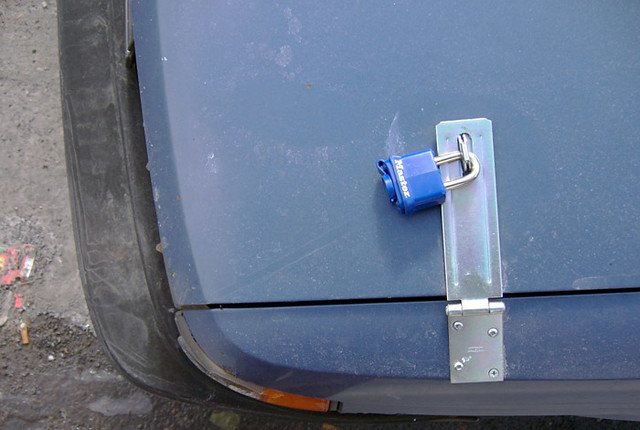Every time we turn the key and hear that all too satisfying click, we take for granted the intricate mechanism that ensures our beloved cars remain safely locked. But have you ever stopped to wonder about the inner workings of your car lock? Perhaps not. Most of us simply trust that our vehicles are securely protected from would-be thieves. However, understanding the anatomy of a car lock can not only provide you with a newfound appreciation for the genius behind this everyday device, but also empower you with the knowledge needed to keep your car and its contents safe. Get ready to dive into the fascinating world of car lock anatomy and unlock the secrets hidden behind those metal doors.
Table of Contents
- Introduction: Understanding the Mechanics Behind Car Locks
- The Key Components: Exploring the Inner Workings of Car Locks
- Security Features: Examining Locking Mechanisms and Anti-Theft Systems
- Common Issues and Troubleshooting Tips: Maintaining and Fixing Car Lock Problems
- Care and Maintenance: Recommended Practices to Prolong Lock Lifespan
- Q&A
- In Retrospect

Introduction: Understanding the Mechanics Behind Car Locks
Car locks are an integral part of our everyday lives, protecting our vehicles from theft and ensuring our peace of mind. Understanding the mechanics behind these locks can help us appreciate their functionality and make informed decisions when it comes to car security. So let’s dive into the fascinating world of car lock mechanics.
At the heart of every car lock is a complex system of tumblers and pins, designed to prevent unauthorized access. These tumblers consist of small metal pieces that align in specific ways to either allow or deny entry. Each lock has a unique combination of tumblers, making it nearly impossible for anyone to pick it without the correct key.
Furthermore, car locks often incorporate high-tech features such as transponder keys and electronic systems, adding another layer of protection. A transponder key contains a microchip that communicates with the car’s immobilizer system, ensuring that only keys with the correct code can start the engine. This advanced technology greatly reduces the risk of car theft and increases overall security.
Whether it’s the classical mechanical tumblers or the modern electronic systems, understanding the inner workings of car locks is not only intriguing but also empowers us to choose the right security measures. So, join us on this illuminating journey as we uncover the mysteries behind car lock mechanics.

The Key Components: Exploring the Inner Workings of Car Locks
Car locks are undoubtedly one of the most crucial components of our beloved automobiles. Understanding their inner workings can help us appreciate their complexity and the importance of their design. When you dig deeper into the anatomy of a car lock, you will discover several key components that work together seamlessly to ensure the security of your vehicle.
1) The Tumbler Pins: These tiny, but mighty pins play a vital role in the mechanism of a car lock. When you insert the key into the lock cylinder, these pins align precisely to create a shear line, allowing the lock to be turned. Each pin has different lengths, requiring the correct key to be inserted for the pins to line up correctly.
2) The Driver Pins: Complementing the tumbler pins, the driver pins maintain constant pressure on the key, ensuring it stays aligned with the lock cylinder. They are designed to fit snugly against the tumbler pins and handle the force from the springs.
3) The Lock Cylinder: Acting as the heart of a car lock, the lock cylinder contains the tumbler and driver pins. Its primary function is to rotate when the correct key is inserted, engaging the ignition or unlocking the doors. The cylinders often come in various shapes and sizes, depending on the car’s make and model.
These intricately designed components collaborate harmoniously to provide us with the essential security needed for our vehicles. Next time you insert your key into a car lock, take a moment to appreciate the inner workings that protect your prized possession.
Security Features: Examining Locking Mechanisms and Anti-Theft Systems
Examining Locking Mechanisms and Anti-Theft Systems
Ensuring the safety of our possessions is a top priority, which is why understanding the various locking mechanisms and anti-theft systems available is crucial. By examining these security features, we can better protect our valuable belongings.
Locking mechanisms have evolved significantly over the years, offering a wide range of options to suit various needs. From traditional key-based locks to advanced biometric systems, each mechanism has its own advantages. Keyless entry systems provide convenience and flexibility, allowing for easy access without the need for physical keys. On the other hand, combination locks offer robust security by requiring precise code input. Additionally, smart locks have gained popularity in recent years, enabling remote control and monitoring of entry points using smartphone applications.
Anti-theft systems complement locking mechanisms by providing an additional layer of protection. There are several types of anti-theft systems available, including:
- Alarm Systems: These systems emit a loud sound and/or trigger notifications when unauthorized access is detected, deterring potential thieves.
- GPS Tracking: By integrating GPS technology, this system allows users to track the location of their possessions in real-time, making recovery easier in case of theft.
- Security Cameras: Surveillance cameras equipped with motion sensors can capture evidence of theft, acting as a deterrent and aiding law enforcement in identifying the culprits.
When selecting locking mechanisms and anti-theft systems, it is crucial to consider the specific needs and risks associated with the items being protected. By understanding the available options, individuals and businesses can make informed decisions to safeguard their valuable assets effectively.

Common Issues and Troubleshooting Tips: Maintaining and Fixing Car Lock Problems
Car lock problems can be frustrating and inconvenient, but with a little knowledge and the right troubleshooting techniques, you can often solve these issues on your own. Here are some common car lock problems and handy tips to help you maintain and fix them:
- Key not turning in the lock: If your key is not turning in the lock cylinder, it could be due to a few reasons. Firstly, check if the key is worn or damaged, as this can hinder its ability to engage properly. If it seems to be in good condition, try lubricating the lock cylinder with graphite powder or a silicone-based lubricant, as dirt and debris may be causing friction. If the problem persists, it could indicate a deeper issue with the lock mechanism itself, which might require professional assistance.
- Jammed or sticky locks: Over time, dirt, dust, and debris can accumulate inside the lock mechanism, causing it to become sticky or jammed. To resolve this issue, use a can of compressed air to blow out any loose debris. For more stubborn dirt, you can also use a small brush or toothbrush to gently remove it. Once the lock is clean, apply a small amount of graphite powder or silicone lubricant to keep it operating smoothly.
- Remote key fob problems: If your car’s remote key fob is not working as expected, it could be due to a dead battery. Try replacing the battery and test the remote again. If that doesn’t solve the issue, it might be necessary to reprogram the key fob, which can usually be done using the owner’s manual or by visiting a local dealership or locksmith.
Remember, troubleshooting car lock problems requires patience and caution. If you’re uncertain or uncomfortable performing any maintenance tasks yourself, it’s always best to seek professional help to avoid causing further damage. By addressing these common car lock issues promptly, you can ensure the security and convenience of your vehicle.
Care and Maintenance: Recommended Practices to Prolong Lock Lifespan
When it comes to keeping your locks in optimal condition, a little care can go a long way. By following some simple practices, you can significantly prolong the lifespan of your locks and ensure their smooth operation for years to come.
Regular Lubrication: One of the most crucial aspects of lock maintenance is lubrication. Apply a few drops of lock lubricant, such as graphite powder or silicone spray, into the keyway every six months to ensure the internal mechanisms function smoothly. Avoid using oil-based lubricants as they can attract dust and debris, causing the lock to become clogged over time.
Protect from the Elements: Exposing your locks to harsh weather conditions can accelerate wear and tear. If your locks are outdoors, consider installing a weatherproof cover or shelter to shield them from excessive sunlight, rain, and snow. Additionally, if your locks are located near saltwater or a corrosive environment, rinse them regularly with fresh water and apply a thin layer of protective sealant to prevent rust and corrosion.
Mindful Key Usage: Treat your keys with care and avoid using excessive force when turning them in the lock cylinder. Forceful key insertion or turning could potentially damage the internal pins and springs, leading to lock malfunctions. It’s also beneficial to periodically clean your keys from dirt and grime to prevent debris buildup within the lock.
Lock Cleaning: Cleaning your locks occasionally can help retain their functionality. Use a soft, lint-free cloth and mild soap solution to wipe away dust and dirt from the lock’s exterior surfaces. Avoid abrasive or chemical-based cleaners that can damage the lock’s finish. Regular cleaning not only keeps your locks looking their best, but it also allows you to identify any signs of wear or damage that may require professional attention.
By following these recommended practices, you’ll ensure your locks maintain their longevity and continue to provide you with security and peace of mind throughout their lifespan.
Q&A
What is the purpose of a car lock?
Car locks are designed to secure vehicles and prevent unauthorized access. They provide a crucial layer of protection, ensuring the safety of both the vehicle and its contents.
How does a car lock work?
Car locks typically use a combination of mechanical and electrical components to provide security. The most common type of car lock is a cylinder lock, which operates with a key and a series of pins or tumblers.
What are the main components of a car lock?
The main components of a car lock include the cylinder, key, pins or tumblers, springs, and the lock housing. When the correct key is inserted, it aligns the pins, allowing the lock cylinder to turn and unlatch.
Do all car locks work the same way?
While most car locks operate on the same principles, there are different types of locks used in vehicles. These include traditional key-and-cylinder locks, remote central locking systems, smart locks, and even biometric systems that use fingerprints or facial recognition.
Can car locks be easily bypassed or picked?
While modern car locks have become increasingly secure, determined criminals may still find ways to bypass or pick them. However, advancements in lock technology, such as anti-pick pins and electronic immobilizers, have made it significantly more challenging for thieves to gain unauthorized access.
What is a transponder key, and how does it relate to car locks?
A transponder key is an electronic device that communicates with the car’s immobilizer system, ensuring that only the key with the matching code can start the engine. It enhances security by adding an extra layer of protection against car theft.
What should I do if I lose my car keys?
If you misplace your car keys, it is best to contact a professional locksmith or your car manufacturer’s dealership. They can provide assistance in replacing or reprogramming your keys to ensure your vehicle remains secure.
Can car locks be susceptible to wear and tear?
Yes, car locks can experience wear and tear over time. Environmental factors, extensive use, and improper maintenance can all contribute to the deterioration of lock components, making the lock less reliable. Regular cleaning, lubrication, and inspections can help prolong the life of a car lock.
Are there any additional security measures I can add to my car locks?
There are several additional security measures you can consider, such as installing a steering wheel lock, using a GPS tracking system, or having an alarm system. These measures can act as deterrents and provide increased peace of mind regarding your vehicle’s security.
In Retrospect
As we conclude our journey through the mesmerizing world of car locks, we hope to have unraveled some of the mysteries that lie behind these seemingly ordinary mechanisms. Just like the intricate tapestry of the human body, a car lock possesses its own unique anatomy, a symphony of pins, tumblers, and cylinders working in harmony to protect our prized possessions.
Next time you approach your vehicle, take a moment to appreciate the silent sentinel that stands guard over your four-wheeled companion. Witness the remarkable interplay of the key as it dances with the tumblers, skillfully finding its way to unlock the hidden treasures within.
From the humble pin tumbler lock to the advanced transponder system, we now comprehend that beneath the simple act of turning a key lies a complex array of intricate design and engineering. And as technology continues to evolve, so too will the car lock, forever adapting to safeguard our vehicles from the prowling hands of modern-day thieves.
So, the next time you embark on a journey behind the wheel, remember to acknowledge the unsung hero that protects your car and grants you peace of mind. Appreciate the elegance of its mechanism and marvel at the ingenuity of those who crafted it.
As we bid adieu to the realm of car locks, let us never take for granted the artistry and science locked within this vital component of our daily lives. Let us respect the craftsmanship and revel in the fusion of form and function that keeps our automobiles safe.
May your adventures be protected, your keys always find their way, and may the anatomy of your car lock forever shelter you on the open road. Farewell, fellow enthusiasts, until we unlock another captivating world together.
As an affiliate, my content may feature links to products I personally use and recommend. By taking action, like subscribing or making a purchase, you’ll be supporting my work and fueling my taco cravings at the same time. Win-win, right?
Want to read more? Check out our Affiliate Disclosure page.